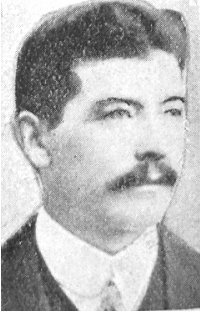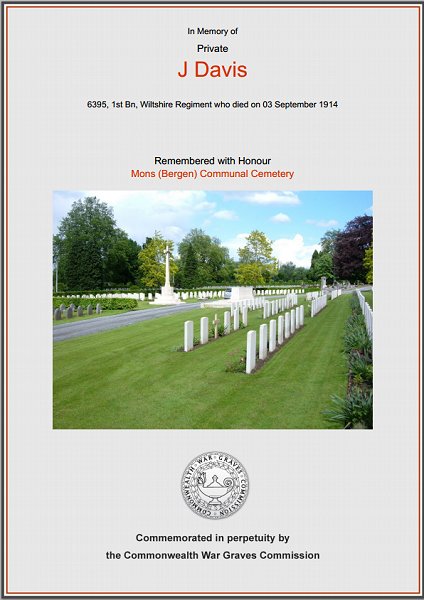yeovil at War
Herbert John Davis
Died in the Retreat from Mons
Herbert John Davis, known as John, was born in Coulsdon, Westbury, Wiltshire in 1884 but very little is known of his early life. From his Service Number 6395 it is known that he joined the 1st Battalion, Duke of Edinburgh's (Wiltshire Regiment) at Devizes, Wiltshire, in the summer of 1903 at the age of 18.
In the 1911 census John was living with his uncle and aunt, George and Sarah Davis, in Frederick Place. John listed his occupation as Army Reservist.
 As
a National
Reservist John
was called up
immediately.
Upon
mobilization and
declaration of
war, the 1st
Wilts, being
based in
Tidworth at the
outbreak of war,
deployed to
France as part
of the 3rd
Infantry
Division's 7th
Brigade, landing
at Rouen, France
on 14 August
1914, taking
part in the
Battle of Mons
just ten days
later.
As
a National
Reservist John
was called up
immediately.
Upon
mobilization and
declaration of
war, the 1st
Wilts, being
based in
Tidworth at the
outbreak of war,
deployed to
France as part
of the 3rd
Infantry
Division's 7th
Brigade, landing
at Rouen, France
on 14 August
1914, taking
part in the
Battle of Mons
just ten days
later.
The Battle of Mons, 23 August 1914, was part of the wider Battle of the Frontiers of France. It was the first battle fought by the British Expeditionary Force (BEF) since its arrival in France during the second week of August. On 22 August the five divisions of the BEF (four infantry and one cavalry) reached the Mons-Condé canal and took up positions along twenty miles of the canal. Sir John French, the commander of the BEF, had been expecting to join a French offensive into Belgium, but this plan had been based on a misunderstanding of the German plan. On 22 August the French had suffered a serious setback at the Sambre, when their Fifth Army had been attacked by the German Second and Third Armies.
During the night of 22 August French received a request to launch a counterattack against what was believed to be the right flank of the German army advancing through Belgium. This belief was mistaken. The German First Army was advancing directly towards the British position - there was no open flank to attack. On 23 August the First Army collided with the thin British line. 70,000 British soldiers with 300 guns faced as many as 160,000 Germans, supported by 600 guns. Although they were badly outnumbered, the British did have two big advantages. Both came from the professional volunteer nature of the British army. Many members of the BEF were long service soldiers, with experience gained in Britain’s colonial wars, but most importantly of all in the Boer War. The British regular soldier of 1914 was expected to be able to fire fifteen aimed shots per minute. At Mons the British rifle fire was so rapid and so accurate that many Germans believed they had been facing massed machine guns.
The second
British
advantage at
Mons was their
willingness to
entrench. At
Mons they found
the ideal
environment for
a defensive
battle. The
canal ran
through a mining
area, and was
thus lined with
mine buildings
and spoil heaps
that provided a
multitude of
potential strong
points. When the
first Germans
reached the
canal on 22
August, the
British were
almost
invisible.
The German
attack on 23
August was badly
organised. At
first the
Germans attacked
as they arrived
on the scene,
allowing the
British to
defeat them
piecemeal. A
more organised
German attack
later in the day
did see German
forces capture a
salient on the
southern bank of
the canal, but
the first days
fighting between
the BEF and the
German army had
gone to the
British.
That night Sir
John French
ordered the BEF
to pull back a
short distance
to the south,
and to create a
new fortified
line. He had
every intention
of resuming the
fight on 24
August. However,
to the east the
French were
still
retreating. A
dangerous gap
was beginning to
open up between
the BEF and the
French Fifth
Army, and so on
the morning of
24 August French
was forced to
order a general
retreat.
This retreat would last for two weeks, and would cost the BEF many more casualties than had fallen at Mons. John was initially reported as being wounded during the retreat, but he sadly died on 3 September 1914. He was aged 30.
John was buried
in Mons (Bergen)
Communal
Cemetery,
Hainault,
Belgium, Grave
IX.E.14 and his
name is
inscribed
on the
War Memorial
in the
Borough.
gallery

The Commonwealth War Graves Commission certificate in memory of John Davis.